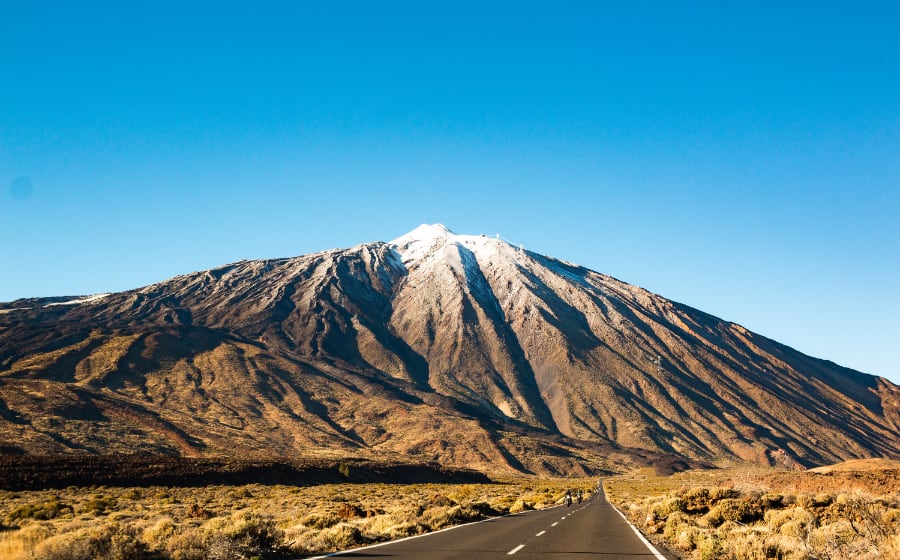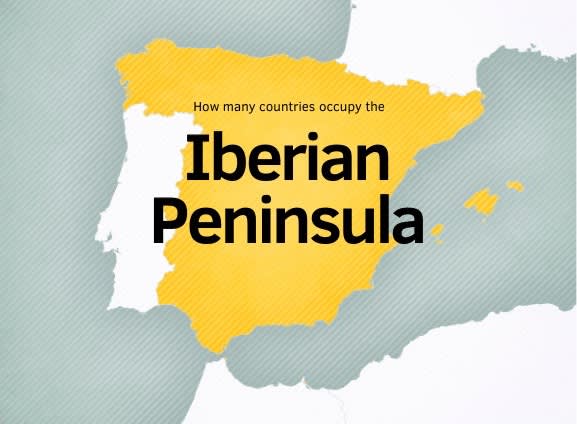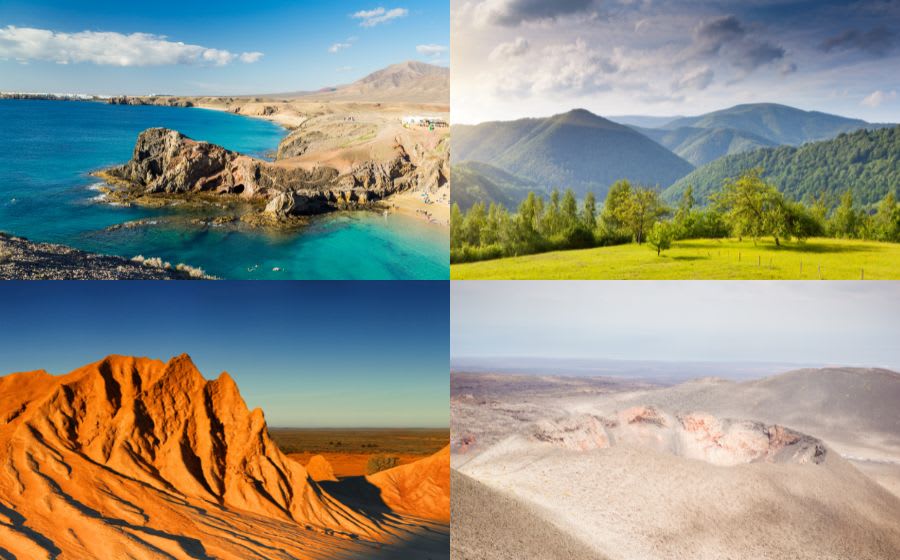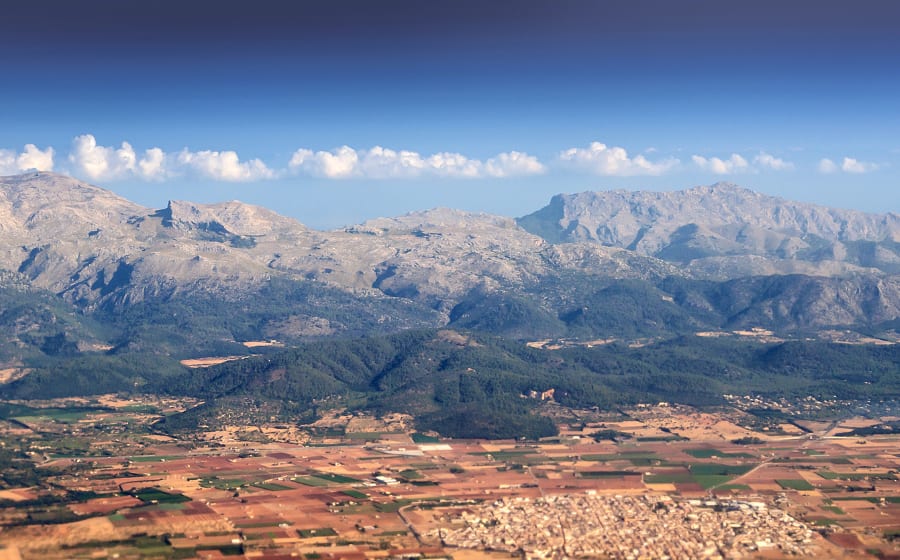The Pyrenees in Spain & France: 12 Questions & Fun Facts
December 14, 2022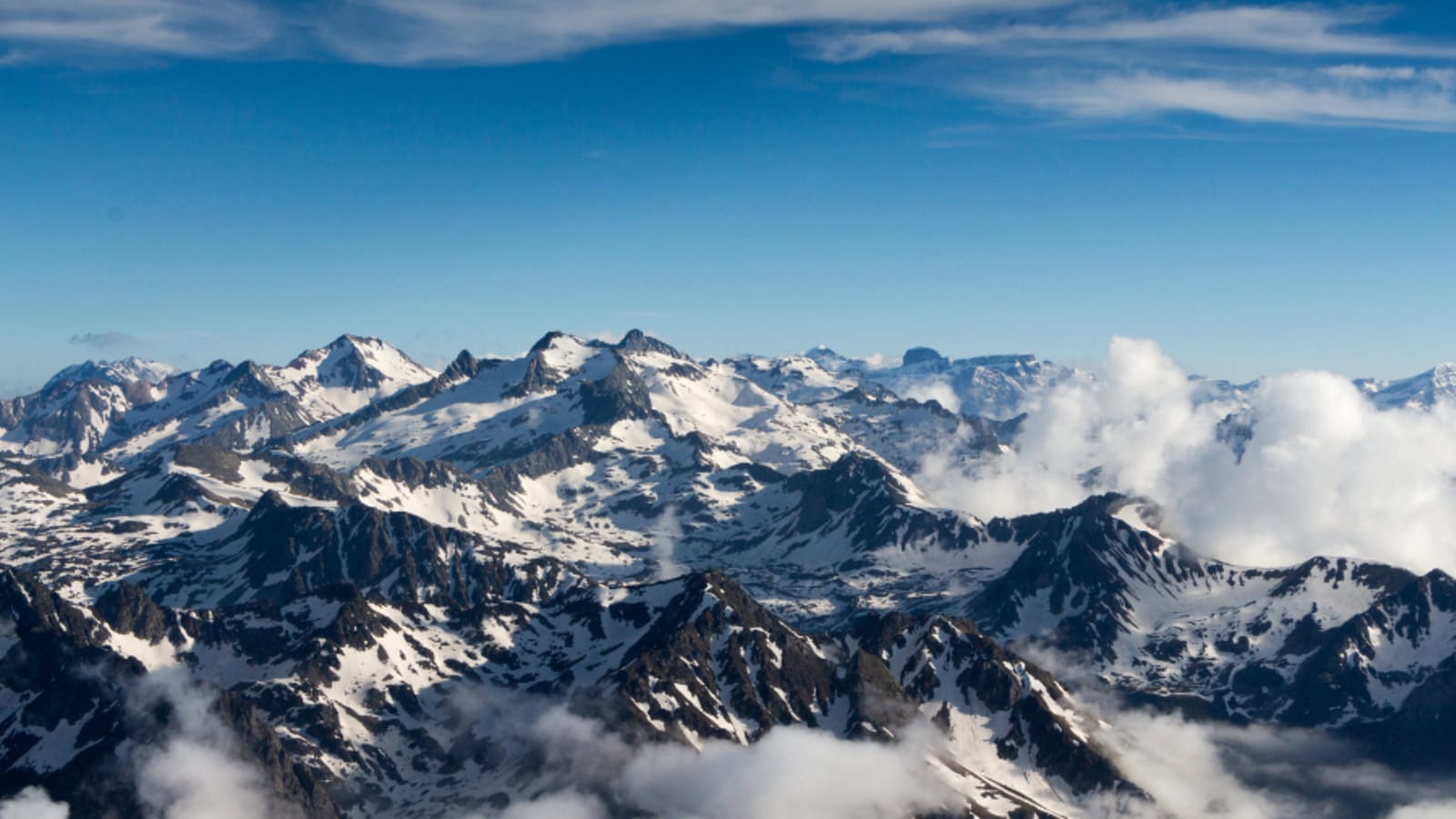
Win a FREE Trip to Spain!
Exciting Announcement! For the first time, we're thrilled to offer exclusive trips to the heart of Spain - an experience like no other. This isn't your typical tourist journey; it's a unique opportunity to immerse yourself in authentic Spanish culture, alongside real locals and our passionate team.
But there's more! Simply by requesting information about this amazing trip, you'll be entered into a special draw to win a Fully Paid Trip to Spain for Two. And that's not all - everyone who inquires will receive an exclusive bonus gift, valued at $500, available only now.
Ready to Discover the Real Spain?Click Here ↑ to Request Information & Enter the Draw!
Do you know everything there is to know about the mountains between Spain and France? There are thousands of pages on the Pyrenees so I will sum things up for you.
Do you enjoy outdoor sports? Or do you simply like to know a bit about everything? Either way, the Pyrenees are for more than one type of adventurer. Everyone finds their place there!
From the meaning of the Pyrenees to one of the smallest countries in the world, there are twelve key facts and fun facts you need to know before visiting.
After this post, you should have the basics for any trip, plus I added other essential information on beautiful lakes.
Table of Contents ▼ ▶
1. What are the Pyrenees?

The Pyrenees are the Spanish-French mountain range that separates the Iberian peninsula from France. These mountains are the tenth largest in Western Europe; before them, the Spanish Sierra Nevada, the Panibaetic System, and the Baetic System occupy positions seven, eight, and nine.
You must distinguish the Pyrenees mountains range from the Great Pyrenees dog breed. If your search is not specific, you might get pictures of very cute dogs.
2. What does the Pyrenees mean?
The meaning of the Pyrenees is the same as before. It is a mountain range that separates two countries and is home to one. The etymology of the word Pyrene is a fire in Greek. But, there is a specific Greek myth that tries to answer the real origin of the Pyrenees name.
Roman senator, Silius Italicus (26 - 101 AD), narrates the myth of Pyrene. She was the virgin daughter of Bebryx, a king from the Mediterranean Gaul (what is supposed to be Southern France) that hosted a night for Hercules. The divine hero was on a quest to steal the cattle from the fearsome giant Geryon, and on the night before he left, he drank in excess and raped Pyrene. Of course, he left her pregnant and went to complete his mission.
Pyrene was ashamed and ran to the woods to avoid his father’s disappointment. She gives birth to a serpent, and while she screams her sorrows to the trees, she attracts wild animals that tear her down. On his way back, Hercule encounters the consequences of his actions, feeling grief and remorse. To give her a dignified tomb, Hercules began to pile rocks, one on top of the other, until the Pyrenees were born.
The previous story is one of the many possibilities for the mountain range’s name. The Greek historian Herodotus argues that the mountains were named after a Celtic town.
3. What does the Pyrenees mean?
The meaning of the Pyrenees is the same as before. It is a mountain range that separates two countries and is home to one. The etymology of the word Pyrene is a fire in Greek. But, there is a specific Greek myth that tries to answer the real origin of the Pyrenees name.
Roman senator, Silius Italicus (26 - 101 AD), narrates the myth of Pyrene. She was the virgin daughter of Bebryx, a king from the Mediterranean Gaul (what is supposed to be Southern France) that hosted a night for Hercules. The divine hero was on a quest to steal the cattle from the fearsome giant Geryon, and on the night before he left, he drank in excess and raped Pyrene. Of course, he left her pregnant and went to complete his mission.
Pyrene was ashamed and ran to the woods to avoid his father’s disappointment. She gives birth to a serpent, and while she screams her sorrows to the trees, she attracts wild animals that tear her down. On his way back, Hercule encounters the consequences of his actions, feeling grief and remorse. To give her a dignified tomb, Hercules began to pile rocks, one on top of the other, until the Pyrenees were born.
The previous story is one of the many possibilities for the mountain range’s name. The Greek historian Herodotus argues that the mountains were named after a Celtic town.
4. What country is in the Pyrenees?
You already know that the Pyrenees are between France and Spain, but there is a country right in the middle of the mountain range.
Andorra is a fascinating country. Due to its location, Andorra is considered the third country of the Iberian Peninsula, as it is landlocked with France in the north and Spain in the South. People would expect either Spanish or French to be the country’s official language, but neither is.
The official language of Andorra is Catalan, and “why?” you might ask. In the 9th century, Charlemagne’s grandson gave Andorra to the count of Urgell (Catalonia), but a few centuries later, the French wanted it back; and ended up sharing custody. Today the country has a Unitary parliamentary constitutional elective diarchy government in which France and the Bishop of Urgell (Catalonia, Spain) share the power.
Being in the middle of the Pyrenees has its advantages and disadvantages. On the one hand, the average high temperature is 17 degrees with a low of 7 degrees; the average minimum temperatures vary between 1 degree in January and 14 degrees in July and August.
And, of course, Andorra is an ideal destination for practicing some skiing in the Pyrenees. Arinsal, Pal, Grau Roig, and La Massana are some of its most famous resorts. It isalsookay to rather enjoy some hot chocolate with a lovely snowy view with Netflix on the back. The thing is that Andorra could be the perfect Christmassy or romantic scenario you were looking for.
5. Are the Pyrenees in Spain or France?
Both. The Pyrenees separate the Iberian Peninsula from Europe, which is the same as acting as a natural border between Spain and France. But, if we want to add numbers to this answer, you should know that the Pyrenees have 129 summits, 3,000 meters above sea level.
Of the 129 summits, 43% belong to Spain, a total of 56 summits; 20% belong to France, which means 26 summits; and 34% or 45 of the summits delimit the border between both countries.
6. How long are the Pyrenees?
The Pyrenees mountain range is 500 kilometers long, the range extends from the Mediterrenean to the Bay of Biscay.
7. What is the highest peak of the Pyrenees?
The Pyrenees’ highest peak is Aneto mountain, 3,404 meters above sea level. It is also the third-highest mountain in Spain on the peninsula after Teide and Mulhacén.
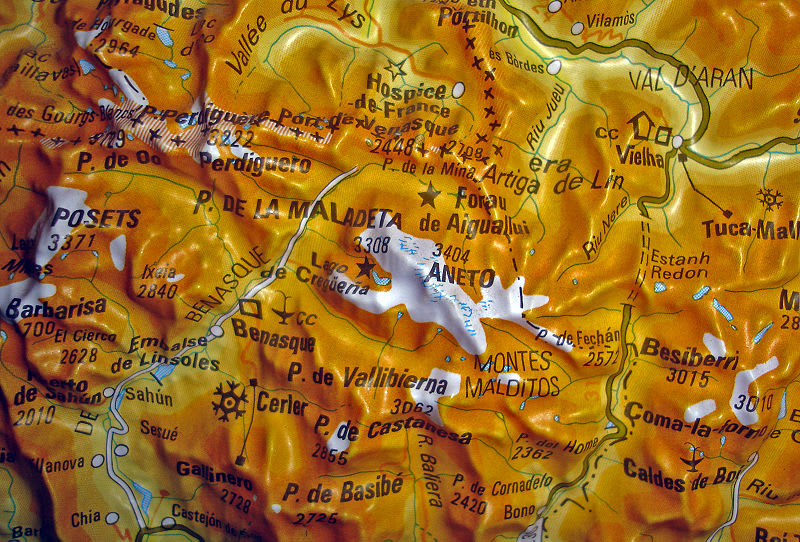
These are the highest mountains in ALL Spain:
8. What are the most important peaks of the Pyrenees?
These are the peaks known as three-thousanders.
| Highest Peaks | Altitude |
|---|---|
| Aneto | 3,404 m |
| Posets | 3,375 m |
| Monte Perdido | 3,355 m |
| Pic Maudit | 3,350 m |
| Cilindro de Marboré | 3,328 m |
| Pic de la Maladeta | 3,308 m |
| Vignemale | 3,298 m |
| Clot de la Hount | 3,289 m |
| Soum de Ramond | 3,263 m |
| Pic du Marboré | 3,248 m |
| Pic de Cerbillona | 3,247 m |
| Pic de Perdiguère | 3,222 m |
| Pic de Montferrat | 3,220 m |
| Pic Long | 3,192 m |
| Pic Schrader | 3,177 m |
| Pic de Campbieil | 3,173 m |
| Pic de la cascade orientale | 3,161 m |
| Pic Badet | 3,160 m |
| Pic du Balaïtous | 3,144 m |
| Pic du Taillon | 3,144 m |
| Pica d’Estats | 3,143 m |
| Punta del Sabre | 3,136 m |
| Pic de la Munia | 3,134 m |
| Pointe de Literole | 3,132 m |
| Pic des Gourgs Blancs | 3,129 m |
| Pic de Royo | 3,121 m |
| Pic des Crabioules | 3,116 m |
| Pic de Maupas | 3,109 m |
| Pic Lézat | 3,107 m |
| Pic de la cascade occidental | 3,095 m |
| Pic de Néouvielle | 3,091 m |
| Pic de Troumouse | 3,085 m |
| Pics d’Enfer | 3,082 m |
| Pic de Montcalm | 3,077 m |
| Grand pic d’ Astazou | 3,077 m |
| Épaule du Marboré | 3,073 m |
| Pic du port de Sullo | 3,072 m |
| Pic des Spijeoles | 3,066 m |
| Pic de Quayrat | 3,060 m |
| Pic des Trois Conseillers | 3,039 m |
| Turon de Néouvielle | 3,035 m |
| Pic de Batoua | 3,034 m |
| Petit Vignemale | 3,032 m |
| Pic de Besiberri Sud | 3,017 m |
| Pic Ramougn | 3,011 m |
| Tour du Marboré | 3,009 m |
| Casque du Marboré | 3,006 m |
| Grande Fache | 3,005 m |
9. What French and Spanish provinces do the Pyrenees occupy?
The Pyrenees occupy Catalonia (Girona, Barcelona, Lleida), Aragon (Huesca), Navarra, and the Basque Country in Spain. On the French side, the mountain ranges go through the following departments Aude, Ariège, Haute-Garonne, Hautes-Pyrénées, and Pyrénées-Atlantiques.
What are the routes to climb the Pyrenees?
There are several routes to discover the Spanish Pyrenees. Some will be more demanding than others, so you must choose accordingly to your hiking level.
- GR- 11: The Pyrenean Trial goes from the Mediterranean side of the Pyrenees to its other end, close to the Bay of Biscay. This trail is very demanding, usually completed in 44 stages, as you can reach an altitude of 2757 m and hike 842,6 km.
- GR-15: The Pre-Pyrenean Path is less demanding than the GR-11 because it goes through the less elevated Spanish side. It goes from Pont de Suert (Catalonia) to Vértice de Algaraieta (Aragon); the route is 240 km and has 14 stages between both points.
- Estany de la Llebreta: If you are looking for a more relaxed route, this one in Catalonia is one of your options. This trail path is in the National Park of Aigüestorte, a 14 km round route that begins in the Valley of Sant Nicolau and ends in Estany de la Llebreta. This path requires effort as any trekking path, but it is very smooth.
If you are here, you can’t miss the Sant Mauritius Lakes in the National Park of Aigüestorte, is a stunning view for your way:
7 Great Lakes in Spain To See in Your Next Visit (with Map!)
- Blue Ibones through Panticosa: If you are a fan of blue glacial waters, you should try this trekking path. It begins in the “Balnearios de Panticosa” (Aragon Pyrenees) until the “Picos del Infierno.” This is a 16 km path in which you will see the stunning ibones of Bachimaña, which mean little glacial lakes in the mountains.
Here you have more information on the Ibón de Bachimaña, if you are close to the balnearios this is a place you can’t miss:
7 Beautiful North of Spain Lakes For a Weekend Retreat
Prat de Cadí: This is a low-difficulty route in the Catalan Pyrenees; it is only 7,6 km. The path goes from the small town of Estana in Lleida to Prat de Cadí mountain.

11. Does the Pyrenees have protected areas?
The Spanish side of the Pyrnees has two protected areas. The first one is the Aigüestortes i Estany de Sant Maurici National Park in Catalonia, and Ordesa y Monte Perdido National Park in Aragon.
12. Are the Pyrenees at risk with climate change?
Climate change is affecting everywhere, and the Pyrenees are no exception. By 2004 the hectares of snow dropped 85% on the Spanish side of the Pyrenees. As the weather gets hotter, the mountains are covered with less snow each year, affecting the biodiversity and the towns that depend on ski tourism.
These mountains between Spain and France will never disappoint you. The beauty of the Pyrenees is undeniable, and it is suitable for any traveler, the hikers, the chill explorers, the skiers, the hot-chocolate enjoyers, etc. I hope this article provided the facts you were looking for and more!




